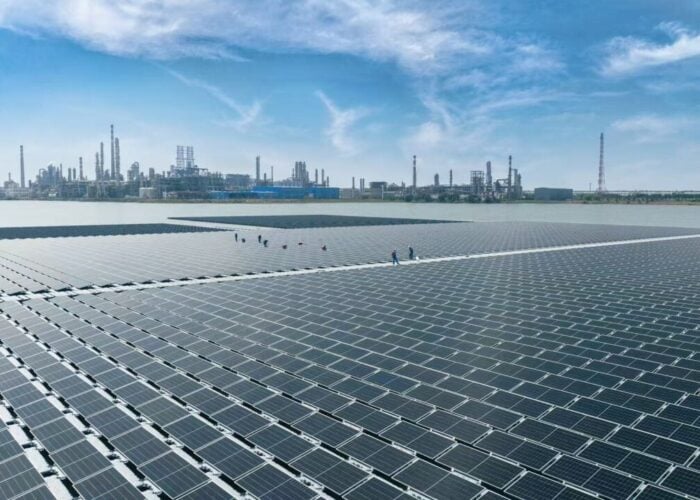
Local PV manufacturers in South Africa are already utilising the government’s announcement of a 10% import duty on solar panels by talking with tier one producers to collaborate on local module assembly facilities for the South African market, a representative of the country’s solar association tells PV Tech Premium.
These manufacturers, who have “taken advantage” of the announcement in June are looking at module assembly for both public and private procurement, says De Wet Taljaard, solar energy technical specialist, at the South African Photovoltaic Industry Association (SAPVIA). They are also looking to take advantage of trade agreements between South Africa and some developed markets, which should lead to an overall increase in the local manufacturing or assembly capacity. However, the tier one companies being approached are predominantly Chinese-owned.
Unlock unlimited access for 12 whole months of distinctive global analysis
Photovoltaics International is now included.
- Regular insight and analysis of the industry’s biggest developments
- In-depth interviews with the industry’s leading figures
- Unlimited digital access to the PV Tech Power journal catalogue
- Unlimited digital access to the Photovoltaics International journal catalogue
- Access to more than 1,000 technical papers
- Discounts on Solar Media’s portfolio of events, in-person and virtual
South Africa only has three operational module assembly facilities, with an estimated cumulative capacity of 620MW per year for larger modules aimed at the utility-scale and commercial and industrial (C&I) segments. Meanwhile, annual demand stood at roughly 3GW over the last two to three years.
“How long it will take for that local assembly capacity to be a real significant percentage of the local demand is yet to be seen,” Taljaard adds.
Furthermore, all these facilities require imports from China of most components for a PV panel, though South Africa can make wires locally and does have a well-developed aluminium industry to enable manufacturing of PV panel frames and structures.
“The limiting factor currently is the module assembly capacity of the local manufacturers,” adds Taljaard. “One assembly plant is currently assembling purely for public procurement schemes, and the other is assembling for retail.
“But they are running at maybe 50-60% of their operational capacity, so they can increase. And they’re looking to fill that spare capacity with assembling for these international entities, and then you won’t have the module import duty on those.”
Response to the 10% duty and rebate
The 10% import duty and rebate were announced formally in June, with the government deciding it was the most appropriate intervention for the market to address the stark gap between local demand and supply. Taljaard emphasises, however, that “the duty currently is a duty in name only” as it is coupled with a rebate mechanism, so effectively it has no impact.
However, there are two potential knock-on effects. Firstly, if the domestic capacity increases, the rebate mechanism may fall away meaning that the 10% import duty burden will likely have to be passed on to energy consumers. Secondly, it adds an administrative burden to PV projects, both in complexity and cost that will be reflected in the overall project costing.
“The administrative mechanisms by the entities responsible for the duty and the rebate mechanisms haven’t kept up with the requests,” adds Taljaard. “So, there’s a bit of a bottleneck there, unfortunately.”
On the other hand, he notes that module prices are playing an ever-decreasing role in the total capex of PV projects, and therefore, a 10% increase coupled with decreasing module costs will eventually lead to the cost per unit evening out.
In August, Xiang Xu, CEO of major Chinese polysilicon producer Daqo New Energy, emphasised this decline in PV costs—noting: “The solar industry experienced significant challenges during the second quarter, as market prices fell across the solar value chain to below production costs for nearly the entire industry.”
Back in early July, SAPVIA released a statement expressing surprise at the lack of consultation with the industry before the government announced the import duty plans.
Local PV manufacturers like Durban-headquartered Artsolar have pushed for an increase in import duties in the past including an application made in 2021 citing several domestic firms shutting down due to “strong competition from low-priced imports”.
Minimal in global context
Protectionism is trending in the global green economy, particularly in electric vehicles (EVs), with the US imposing a 100% tariff on Chinese-made EVs, says Thilasoni Chikwanda, executive director, Africa Sustainable Investors, an energy services company focused on commercial-scale solar solutions. In this global context, combined with decreasing solar panel and equipment costs, South Africa’s 10% import duty should not have a significant impact on the consumer sector, he believes.
However, given that local PV demand is five times more than local supply, Chikwanda adds: “To slap a 10% tariff to protect 20% seems pretty high. It doesn’t seem proportionate. But if you consider the fact that you’ve grown the industry to 20% and you need to grow it [further], typically, you need economies of scales and for the cost of local production to become internationally competitive.”
Ultimately, the government is trying to balance its industrial strategy with its energy strategy. Chikwanda suggests the burden on consumers will be little in the short term and that in the long term the costs for the consumer should come down and the duty should create more jobs and more local content.
“I would support the policy and I think 10% is a moderate tariff related to what’s going on elsewhere in the world,” he adds. “The political environment is favourable for investment, which hopefully should attract investment in the energy sector—both solar and wind energy—to displace coal. So, that’s good news for people who are assembling panels.”







